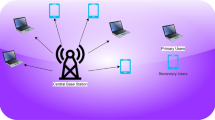Abstract
Cognitive radio ad hoc networks (CRAHNs) were developed to improve the utilization ratio of licensed spectrum. Since spectrum opportunities for users are varied over time and location, enhancing the spectrum effectiveness is a goal and also a challenge for CRAHNs. Besides, due to the energy limitation of the devices in CRAHNs, energy efficiency is another goal to be achieved. Therefore, the objective of this paper is to design a spectrum- and energy-efficient routing (SEER) protocol for CRAHNs, which improves transmission efficiency and balances energy consumption. The design of the protocol uses the techniques of expected transmission power, expected residual lifetime and utility indifference curves. The protocol will select the optimal route from all candidate paths. We present a performance comparison with two existing protocols for CARHNs: the minimum total transmission power (MTTP) and the min–max battery cost (MMBC) protocols. Simulation results show that SEER can reduce energy consumption by almost 40 % than that of MMBC, and increase network lifetime by almost 200 % than that of MTTP. Besides, SEER can improve the network throughput by at least 50 % and 150 % than that of MTTP and MMBC respectively.









Similar content being viewed by others
References
Akyildiz, I. F., Lee, W. Y., Vuran, M. C., & Mohanty, S. (2006). NeXt generation/dynamic spectrum access/cognitive radio wireless networks: A survey. Elsevier Computer Networks, 50, 2127–2159.
Akyildiz, I. F., Lee, W. Y., & Chowdhury, K. R. (2009). CRAHNs: Cognitive radio ad hoc networks. Elsevier Ad Hoc Networks, 7(5), 810–836.
Kamruzzaman, S. M., Eunhee, K., & Dong G. J. (2011) Spectrum and energy aware routing protocol for CRAHNs, IEEE International Conference Communications (ICC).
Cesana, M., Cuomo, F., & Ekici, E. (2011). Routing in cognitive radio networks: Challenges and solutions. Ad Hoc Networks, 9(3), 228–248.
Chowdhury, A. R., & Akyildiz, I. F. (2011). CRP: a routing protocol for cognitive radio ad hoc networks. IEEE Journal of Selected Areas in Communications, 29(4), 794–804.
Mahmoodi, T. (2011). Energy-aware routing in the cognitive packet network. Performance Evaluation, 63(4), 338–346.
Gelenbe, E., & Lent, R. (2004). Power-aware ad hoc cognitive packet networks. Ad Hoc Networks, 2(3), 205–216.
Pyo, C.W., Hasegawa, M. (2007) Minimum weight routing based on a common link control radio for cognitive wireless ad hoc networks, in: IWCMC’07: Proceedings of the 2007 International Conference on Wireless Communications and Mobile Computing, pp. 399–404.
Chiaraviglio, L., Matta I. (2010) GreenCoop: Cooperative green routing with energy-efficient servers. Proceedings of ACM First International Conference on Energy-Efficient Computing and Networking (e-Energy’10), NY, USA.
Liu, K. J. R., & Wang, B. (2010). Cognitive radio networking and security: A game-theoretic view. Cambridge: Cambridge University Press.
Kamruzzaman, S. M., Eunhee K, Dong G. J. An energy efficient QoS routing protocol for cognitive radio ad hoc networks, International Conference on Advanced Communication Technology (ICACT).
Tabrizi, H. Joint cooperative routing and energy-aware routing for maximizing wireless network lifetime, Standford Unviersity, Technical Report [Online]. www.stanford.edu/htabrizi/report.pdf.
Khattab, A., Perkins, D., Bayoumi, M. (2013) Opportunistic spectrum access challenges in distributed cognitive radio networks, Cognitive Radio Networks Analog Circuits and Signal Processing, 33–39.
Lo, B. F., & Akyildiz, I. F. (2013). Reinforcement learning for cooperative sensing gain in cognitive radio ad hoc networks. Wireless Networks (Springer), 19(6), 1237–1250.
Guan, Q., Yu, F. R., Jiang, S., & Wei, G. (2010). Prediction-based topology control and routing in cognitive radio mobile ad hoc networks. IEEE Transactions on Vehicular Technology, 59(9), 4443–4452.
Kim, D. K., & Adachi, F. (2001). Theoretical analysis of reverse link capacity for an sir-based power-controlled cellular CDMA system in a multipath fading environment. IEEE Transactions on Vehicular Technology, 50(2), 452–464.
Pätzold, M., Szczepanski, A., & Youssef, N. (2002). Methods for modeling of specified and measured multipath power-delay profiles. IEEE Transactions on Vehicular Technology, 50(5), 978–988.
Ding, L., Melodia, T., et al. (2010). Cross-layer routing and dynamic spectrum allocation in cognitive radio ad hoc networks. IEEE Transactions on Vehicular Technology, 59(4), 1969–1979.
Hsu, A., Wei, D., Kuo C., (2007) A cognitive MAC protocol using statistical channel allocation for wireless ad-hoc networks. Proceedings of the IEEE WCNC.
Kim, D., et al. (2003). Routing mechanisms for mobile ad hoc networks based on the energy drain rate. IEEE Transactions on Mobile Computing, 2(2), 161–173.
Kim, D., et al. (2002) Power-aware routing based on the energy drain rate for mobile ad hoc networks. Proceedings of Eleventh International Conference on Computer Communications and Networks, pp. 565–569.
Colletter, Y., & Siany, P. (2003). Multiobjective optimization: Principles and case studies, decision engineering. Berlin: Springer.
Hou, Y., Shi, Y., Pan, J., Efrat, A., & Midkiff, S. (2006). Maximizing the lifetime of wireless sensor networks through single-session flow routing. IEEE Transactions on Mobile Computing, 5(9), 1255–1266.
Cano, J.-C., Manzoni, P. (2000) A Performance comparison of energy consumption for mobile ad hoc network routing protocols. Proceedings of MASCOTS, pp. 57–63.
Acknowledgments
This work was supported by City University Strategic Research Grant No. 7002734.
Author information
Authors and Affiliations
Corresponding author
Rights and permissions
About this article
Cite this article
Hou, L., Yeung, K.H. & Wong, K.Y. SEER: spectrum- and energy-efficient routing protocol for cognitive radio ad hoc networks. Wireless Netw 21, 2357–2368 (2015). https://doi.org/10.1007/s11276-015-0906-3
Published:
Issue Date:
DOI: https://doi.org/10.1007/s11276-015-0906-3




